Oregon is one of the most beautiful states in America. With a variety of terrain and fantastic growing conditions, Oregon is one of the country’s leaders in agriculture. The state ranks in the top five producers of quite a few different crops.
Oregon has some of the most fertile land in the nation, and it’s due to the soil content. Oregon’s soil is volcanic, which in turn, makes the soil fungal. A rich fungal content in the soil helps make the soil more fertile. Plants can thrive alongside earthworms and voles in the dirt of Oregon.
15,700,000 acres of farmland take up a massive percentage of the state’s total area. Oregon values its role in the agricultural industry of America and produces fruits, hay, wheat, and more. For a full understanding of Oregon’s agricultural successes, check out this list of the top 10 most valuable crops in Oregon based on the USDA‘s agricultural reports.
10. Apples

Farmers can harvest apples in Oregon between July and November.
©JACEK SKROK/Shutterstock.com
The tenth-most valuable crop in Oregon is the apple. In 2022, Oregon farmers harvested 5,000 acres of apples. $40 million apples were used in 2022. It’s not often that a state’s tenth-most valuable crop is worth such a substantial amount! Clearly, Oregon is producing a lot of quality goods.
Of the 32 states that produce apples, Oregon ranked sixth in production. Washington state is the number-one apple-producing state in America. In 2022, they produced almost 63% of the country’s apples. Oregon, on the other hand, grew only 1.39%, despite contributing 136,000,000 pounds of apples.
Oregon grows a wide variety of apple types. The most predominantly grown apples in the state are Fuji and Gala. Granny Smith and Honeycrisp apples follow closely behind in terms of production. Oregon exports a lot of its apples out of the state.
9. Cherries
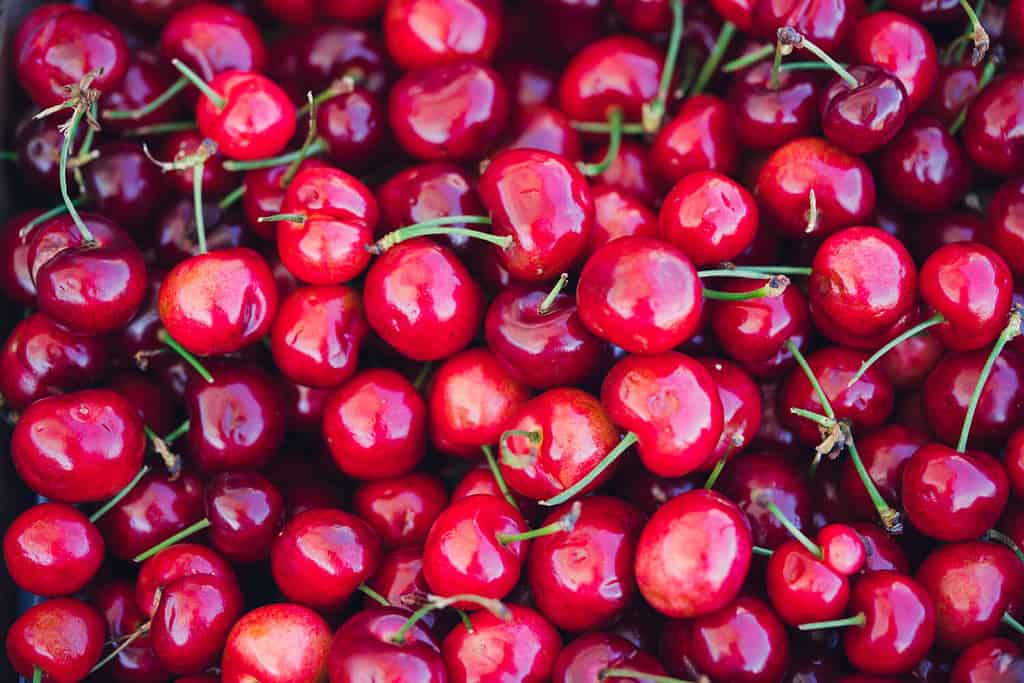
Farmers have dedicated 11,500 acres of land to growing cherries within the state of Oregon.
©veeterzy/Shutterstock.com
Cherries are Oregon’s ninth-most valuable crop. Most of the cherries go to fresh market uses, and that is worth $63,150,000 in value. A small percentage of cherries are processed, adding an additional $5 million in value to Oregon’s cherry crop.
Oregon is the third-ranked state in cherry production. It follows behind California and Washington. In 2022, Washington produced just under 200,000 tons of sweet cherries, while Oregon produced around 40,000 tons. The three states together, however, produce 90% of the cherries grown in America. When it comes to tart cherries, however, Michigan takes the first-place spot.
Within Oregon, farmers grow cherries in a few different valleys. The Willamette Valley and Mid-Columbia Valley are where the majority of the cherries in the state are grown. The Willamette Valley is a famous stretch of land that produces some of the most highly-ranked wines in the United States! The land is perfect for grapes and cherries, it seems.
8. Hops

Oregon farmers harvest over 14% of America’s hops.
©MaxyM/Shutterstock.com
Taking the spot as the eighth-most valuable crop in Oregon is hops. In 2022, 7,756 acres of hops were grown in the state. Hops alone were valued at $85,105,000. Over 13 million tons of hops were grown in Oregon in 2022!
The state that produces the most hops is Washington. 73% of all hops grown in America were grown in Washington in 2021. That year, Oregon produced 11% of the crop. Idaho took the second-place spot, producing 16% of total hops.
The primary use of hops is to produce beer. Hops add a lot of flavor to a beer and are an important part of what makes the drink. Hops in Oregon are mostly grown in the Willamette Valley. Oregon is known as the creator of a few important varietals of hops, including the Cascade hop. Portland is one of the craft beer capitals of the country, and Oregon’s hop production is likely an important part of that!
7. Corn
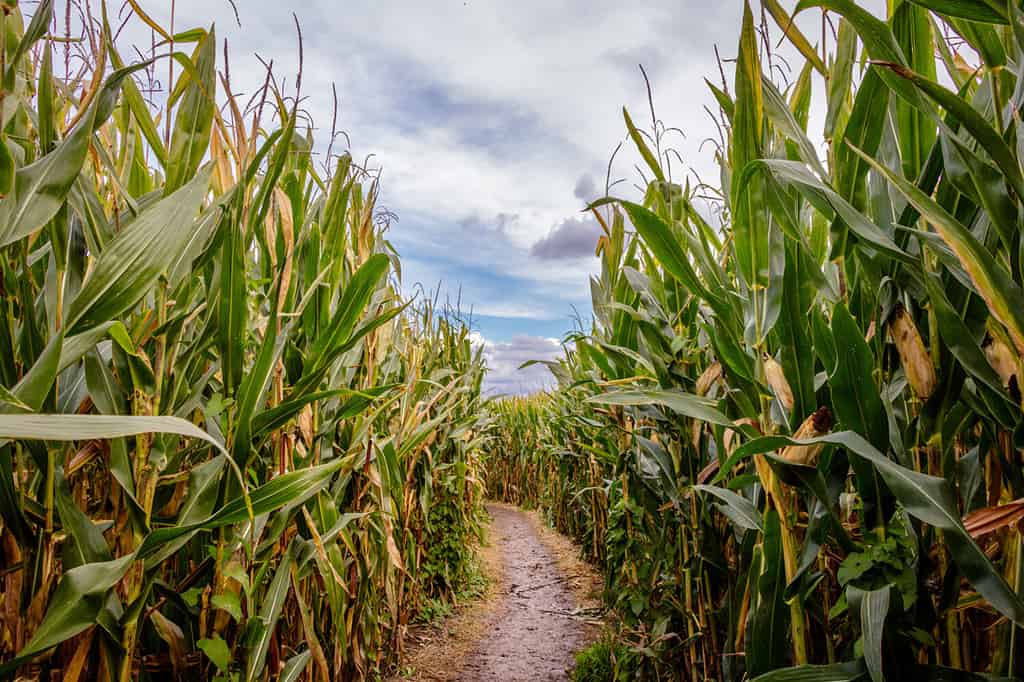
Grain corn produced almost $90 million of value for Oregon.
©Dennis Wegewijs/Shutterstock.com
Oregon farmers grow a significant amount of corn. In 2022, 45,000 acres were harvested for grain while another 34,000 acres were harvested for silage. These two types of corn made up Oregon’s seventh-most valuable crop.
While Oregon produces a massive amount of corn, the state doesn’t rank in the top ten states for corn production. The leader in corn for grain is Iowa, and the leader in corn for silage is Wisconsin. Iowa’s corn production in 2022 produced a massive amount of value. It’s the state’s most prominent crop, producing almost $17 billion.
Most Oregon corn grows in the Willamette Valley. Corn is the biggest crop in terms of total production in the United States, and while Oregon adds to the total, it can’t compete with states in the Corn Belt. The Corn Belt is made up of most of the states in the Midwest. The US is a massive leader in corn production in the world, exporting a significant amount of the crop to other countries.
6. Pears

Most pears produced in Oregon were used for fresh market purposes, while 15,680 tons were processed.
©slowmotiongli/iStock via Getty Images
Oregon grows a lot of pears. They are the state’s sixth-most valuable crop. In 2022, 13,700 acres of pears were harvested, rearing almost 200,000 tons of the fruit. Utilized pears were valued at $90,752,000 in 2022.
Oregon is one of only six states that grow pears. Washington, Oregon, and California dominate the market. Washington produced $160,078,000 worth of pears in 2022. Most of their pear crop was also used for fresh market purposes, with just under 65,000 tons used for processing.
The United States exports a large amount of pears. Exports of pears totaled 244 million pounds of fresh pears and 6.2 pounds of preserved pears in 2022. While the US is a prominent pear producer, China and the Netherlands lead the pear crop industry.
5. Hazelnuts
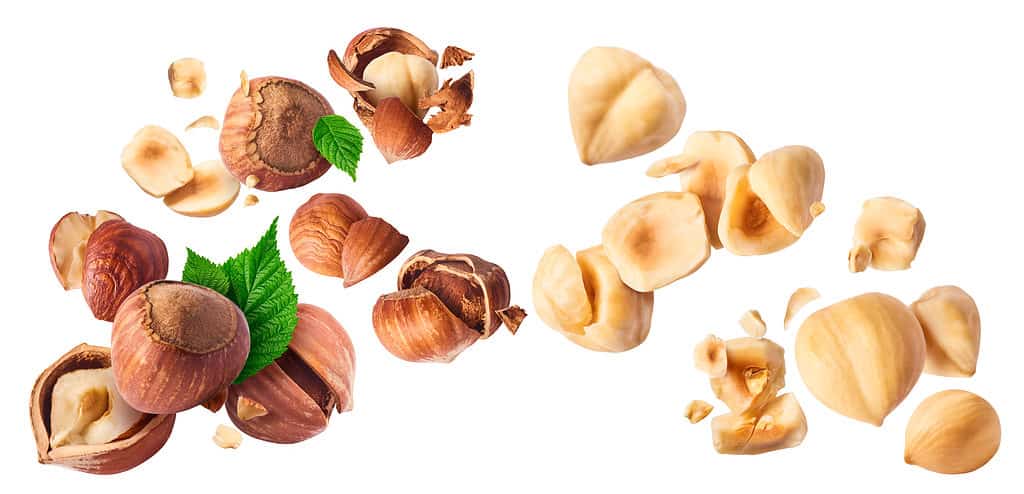
1,000 farms grow hazelnuts in Oregon!
©Agave Studio/Shutterstock.com
Hazelnuts are Oregon’s fifth-most valuable agricultural good. In 2022, there were 68,000 acres of harvested hazelnuts. The nut produced $100,750,000 in value. While the nut can be de-shelled, most were intact when sold. Hazelnuts, in general, are an extremely valuable good. Each ton of hazelnuts is worth $1,300!
Oregon is in first place for hazelnut production in the United States. In fact, Oregon produced 99% of the hazelnuts in the United States in 2017. Washington contributes a small portion of hazelnuts, but it isn’t substantial.
Oregon’s hazelnut growth has an impact on the world’s nut industry. The United States produces 3-5% of the hazelnuts on Earth. The majority of that is from the 68,000 acres of harvested land in Oregon! Turkey is the largest producer of hazelnuts worldwide and, in 2021, the country harvested 64% of the world’s hazelnuts.
4. Blueberries
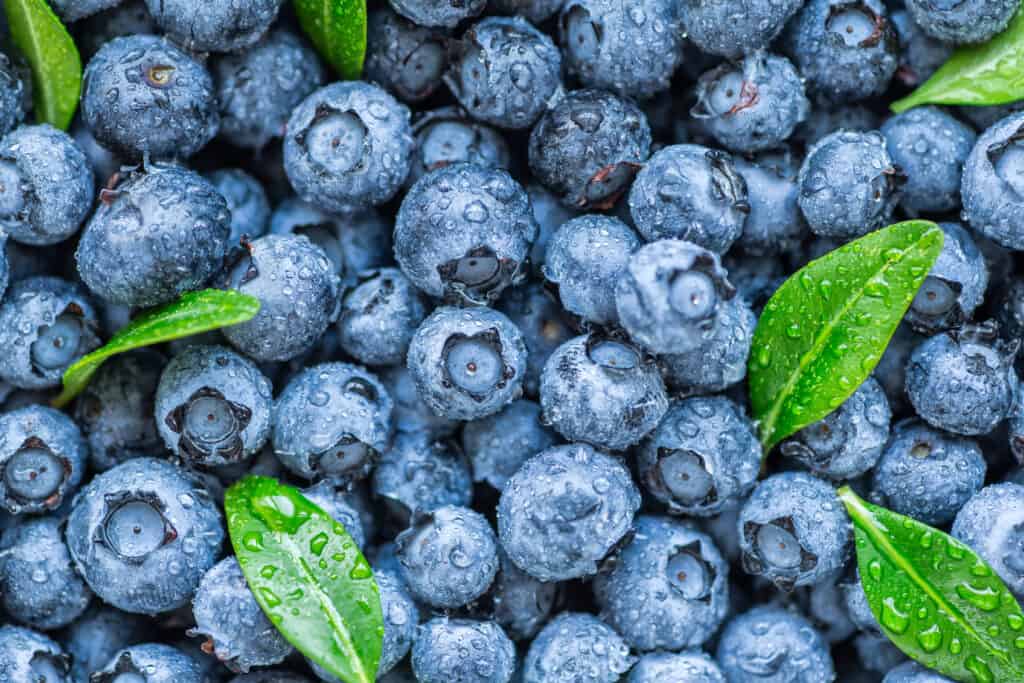
Oregon grows tame blueberries in large quantities! 13,200 acres of blueberries were harvested in 2022.
©Bukhta Yurii/Shutterstock.com
Oregon has a fantastic climate for growing berries. Between the blueberries that were utilized for fresh market purposes and those that were processed, Oregon produced $182,785,000 in value with blueberries. Just over $100 million were for the fresh market, while just under $80 million were processed.
Only 26 states in the United States grow blueberries, and only 10 states do it well. Oregon, Washington, Georgia, Michigan, California, New Jersey, North Carolina, Florida, Texas, and Minnesota produce 98% of the blueberries grown in America. Washington, once again, takes the cake as the leader. 90,000 tons of blueberries are produced yearly, yielding over $220 million in value.
Interestingly enough, the leader of blueberry production in the world is the small South American country of Peru. At one time, the US, Canada, and Chile were the prominent producers, but Peru has overtaken the first place spot. The country produces 270,000 tons of the berry annually.
3. Potatoes
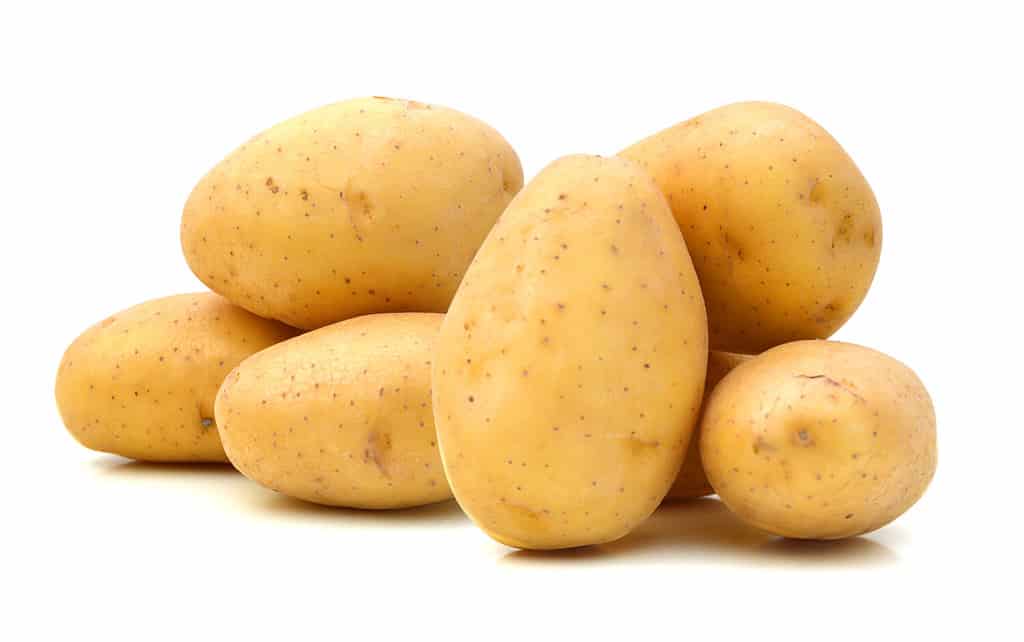
Oregon grows many varieties of potatoes, including russets and fingerlings.
©Hong Vo/Shutterstock.com
The third-place spot for the most valuable crop in Oregon goes to potatoes. In 2022, farmers planted 43,000 acres of potatoes, producing $265,740,000 in value. Overall, Oregon holds the fourth-place rank in the nation for potato production.
The first place spot for potato production in the United States is Idaho. Idaho grows over six times as many acres of potatoes as Oregon does. In 2022, Idaho produced $1,509,313,000 in value with potato farming. And that’s not even Idaho’s number-one crop! Washington, Wisconsin, and North Dakota also rank highly in potato production.
The largest potato producer in the world is China, followed by India. The two countries together produce a third of the total potatoes grown in the entire world. The United States takes the fifth-place spot for potato production. In 2021, the global production of potatoes was at 376 million tons. However, the US only contributed 18.5 million of those tons.
2. Wheat

Wheat’s price per unit isn’t very high, so farmers have to harvest a lot of the crop in order to produce such high value.
©Khawaja gulam fareed/Shutterstock.com
The second-most valuable crop grown in Oregon is wheat. In 2022, 730,000 acres of wheat were planted. From the 715,000 acres that were harvested, Oregon produced $470,016,000 in value from the crop.
Despite being a large crop in the state, Oregon doesn’t rank highly in the country for wheat production. Kansas was the number-one wheat producer in 2023, growing 22% of the country’s total wheat. Wheat production in Kansas is worth over $2 billion. North Dakota, Oklahoma, Montana, and Washington round out the top five producers of wheat in the country.
Once again, China takes the top spot for production. Of all the wheat grown in the world, 17% is grown in China. The United States isn’t in the top ten producers of the crop worldwide. The European Union and India follow behind China in the production of wheat.
1. Hay
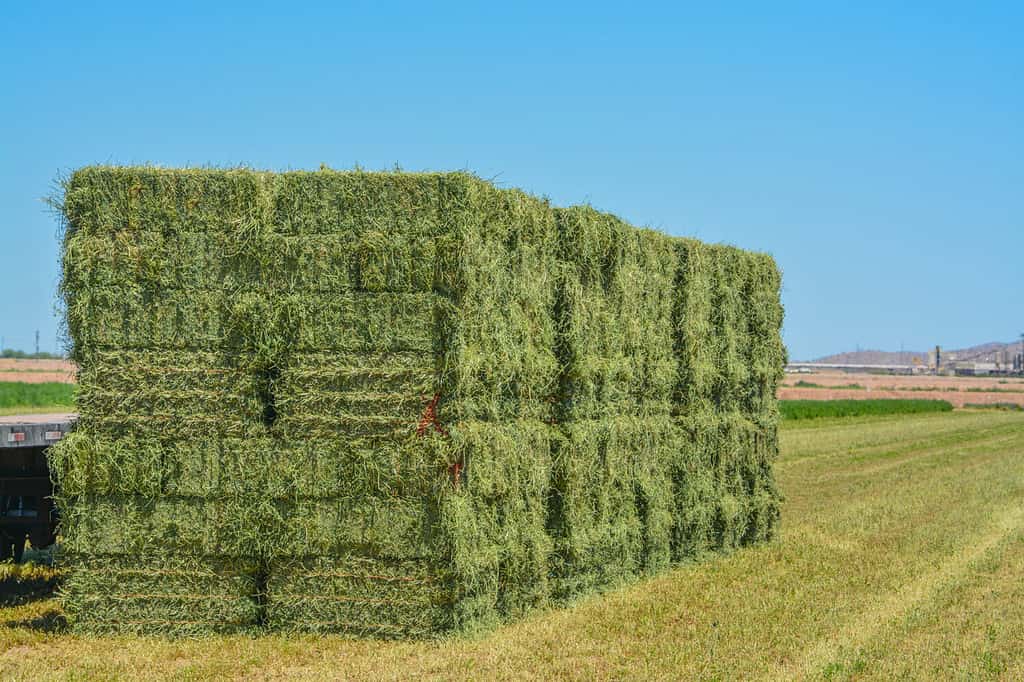
Oregon grows alfalfa and non-alfalfa hay.
©Norm Lane/Shutterstock.com
The most valuable crop produced in Oregon is hay. In 2022, farmers harvested 820,000 acres of hay which equated to $797,183,000 in value. Alfalfa hay made up $491,260,000 of the total value, while non-alfalfa hay made up $305,923,000 of the total value. However, non-alfalfa hay takes up more acreage. The price per unit is much lower for non-alfalfa hay than alfalfa hay.
Oregon is not a leader in the country for hay growth. Hay is a large crop in the United States, and the leaders produced billions in value. Texas is the leader in all hay, while Idaho leads in alfalfa hay. Texas produced $1,288,050,000 worth of hay in 2022, while Idaho produced $1,253,450,000 of alfalfa hay in 2022.
The United States is the global leader in hay production. America exports the most hay of any country, with Australia and Spain trailing behind. Consumers primarily use hay for feeding livestock, so it’s an important good in the worldwide food industry.
The photo featured at the top of this post is © Svetlana_Smirnova/Shutterstock.com
Thank you for reading! Have some feedback for us? Contact the AZ Animals editorial team.







